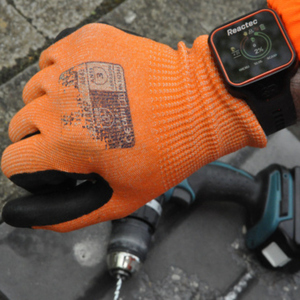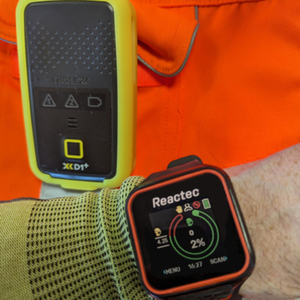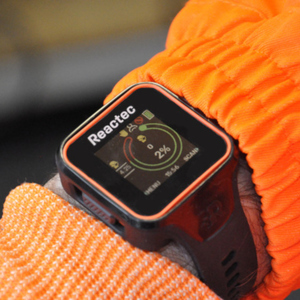
 |
Mark Sennett
Managing Editor |
 |
Kelly Rose
Editor |
| Home> | Breathing Safely | >Dust and Fume Extraction | >Making the invisible, visible |
| Home> | Managing Health & Safety | >Environmental Monitoring | >Making the invisible, visible |
| Home> | Breathing Safely | >Gas Detection and Monitoring | >Making the invisible, visible |
Making the invisible, visible
24 June 2024
REACTEC REVIEWS the current impact of dust-related occupational ill-health in the UK and explores how connected worker technology can help you to manage exposure.

Monitoring your workers’ exposure to potentially harmful dust particles presents unique and often an invisible challenge that traditional approaches to risk management simply cannot address.
In contrast to noise, for example, which a person will be able to hear if it’s loud enough to potentially harm their hearing, dust isn’t always visible to the naked eye. And dust, unlike some other workplace risks, can remain an active threat to workers even after the activity which creates the dust has ceased.
This is partly because dust particles can remain in the air for a staggering 20 or more days, but also because negative health outcomes resulting from exposure to dust are often felt years after the exposure actually took place.
So, even if your team is taking steps to protect your workers from potentially dangerous dust, it’s entirely possible that dust might still pose a serious threat to their health and wellbeing.
In this article, we’ll review the current impact of dust-related occupational ill health in the UK, and explore how organisations can adopt an approach to dust monitoring and management that meets these unique challenges to better support worker health and safety.
Dust can pose an invisible and unpredictable threat to workers
It would be difficult to overstate the danger that dust poses to workers in the UK.
Each year in the UK alone, approximately 12,000 people die from diseases linked to past exposure to dust at work. Another 600,000 people are exposed to silica dust, a particularly dangerous type of dust and known carcinogen 1 that’s found in many materials which are common on a variety of worksites, including stone, rock, sand, gravel, and clay. 2
Aside from the fact that dust is microscopic and all-but impossible to eliminate entirely from standard workplaces, it’s also uniquely difficult to monitor and manage for other reasons. One of the many challenges that teams face when trying to control their workers’ exposure to dust is the reality of how dust can affect different individuals in very different ways. The harm caused by exposure to dust ranges from skin irritation to cancer, and it’s difficult to determine what dust - or how much - will cause which problems in any one person. This is one key reason why one-size-fits-all approaches to occupational dust monitoring fall short of well and truly protecting your workforce.
Dust monitoring technology to enable faster action and deeper insight
Traditionally, teams have relied upon third-party assessments of their risk environment with regard to dust in order to keep their workers safe and protected. And while such assessments may provide a useful baseline for determining the type and amount of dust in a given workplace during a specific point in time, they do not provide the real-time, accurate information that’s required to understand an individual workers’ actual exposure.
Last year, Trolex - a pioneer in safety technology - partnered with Reactec to bring more effective dust monitoring to the UK’s workplaces. The Trolex XD1+ is designed to be the lightest weight, most practical personal dust monitoring technology on the market. With no filters, pumps, tubes, or replaceable parts, the XD1+ is incredibly compact and easy to use. Workers only need to switch it on and secure it in place, and they’re ready to get to work.
And now, workers can pair their XD1+ with their R-Link watch to view their own dust exposure levels right on their watch face. Previously, live data was sent from the XD1+ to Reactec Analytics, where supervisors and duty holders could view it in near real-time and make immediate interventions when necessary. This latest update enables even quicker action, making it possible for workers to respond more immediately to real-time exposure data which they can access at any moment.
And of course, individual workers’ exposure data is stored and analysed in Reactec’s ultra-secure, powerful Analytics platform, which transforms information from the field into actionable intelligence that organisations can use to drive better, more informed decision-making. And since data from the XD1+ can be overlaid with any other exposure data from your Reactec Analytics - like vibration, noise, or dangerous proximity - you’ll have an unprecedented 360-degree view of your workplace risk environment. With this level of insight, you can identify patterns, trends, and hotspots, and take action to adjust ways of working, or refine your controls.
Monitoring your workers’ exposure to potentially harmful dust particles presents unique challenges that traditional approaches to risk management simply could not adequately address.
But modern solutions are purpose-built to provide you with invaluable insight that can help keep your workers safe and protected, all while facilitating a seamless user experience that’s designed to make adoption fast and easy.
References
1. A carcinogen is a substance which is capable of causing cancer
2. Specifically, silica is a mineral which is found in many materials. When it’s not inhaled, it’s not dangerous to humans. But when silica becomes silica dust, it becomes extremely hazardous to our health.
For more information, visit www.reactec.com


























